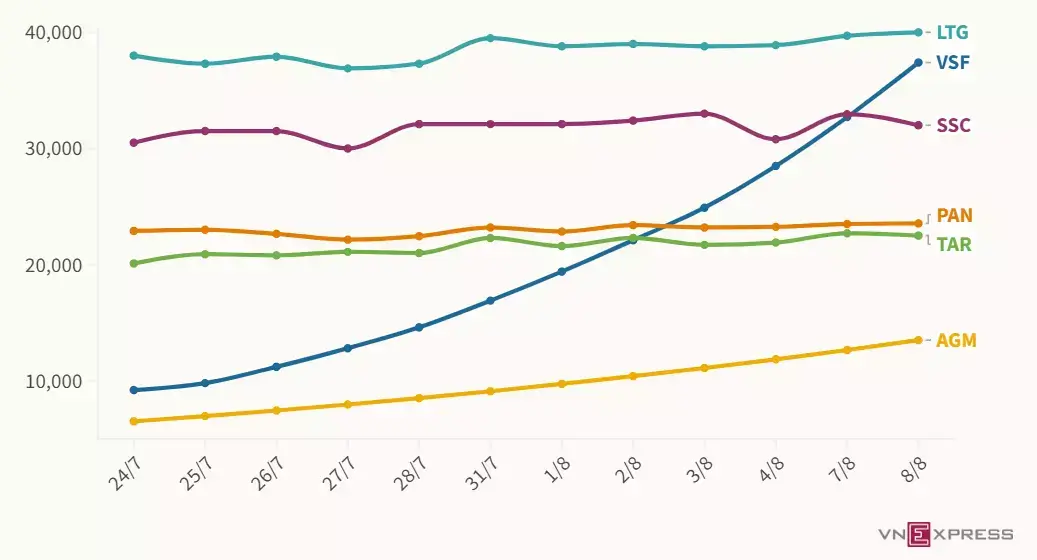Stock market (January 11): ‘Vingroup’ flourished, VN-Index increased by more than 17 points
The market continued to prosper in the first session of the week. Stocks of VHM, VIC, BCM, HVN, and VJC
The stock ticker of Southern Food Corporation (Vinafood II - VSF) hit the ceiling at the beginning of today's session. It extended 8 consecutive purple sessions and helped this stock hit the ceiling for 11 sessions in the last two pants. The market price of VSF is 37,400 dong per unit, the highest level in the listing history of this enterprise.
AGM shares of An Giang Import-Export Joint Stock Company (Angimex) doubled their market price in just two weeks. This code is trading at 13,500 dong per unit, the same price range at the end of October last year.
Trading is restricted, but AGM has had 12 consecutive purple-to-ceiling sessions from July 24. Besides the two popular stocks mentioned above, other stocks in the rice industry also raised the market price by a large margin during the past month.
The TAR of Trung An Hi-Tech Agriculture has increased by more than 40% since the beginning of July, currently equivalent to the price range in September 2022. LTG of Loc Troi Group accumulated 32% more and returned to the market price level of June 2022. Some stocks, such as PAN and SSC, also recovered to the price range in the third quarter of 2022, when export rice prices increased.
The market price of some rice stocks from July 24 to August 8

In a document sent to the State Securities Commission, the leadership of VSF and AGM confirmed that they did not affect the trading price on the market. According to them, stock prices are determined by supply and demand in the market and are beyond the control of enterprises.
Angimex added that the reason is that the world and Vietnam rice prices continue to increase.
It is a consequence of the conflict between Russia and Ukraine and the influence of El Nino weather conditions. Besides, India, Russia and the United Arab Emirates (UAE) also banned rice exports, causing food prices to skyrocket. The market has continuously raised the export price of Vietnam's rice over the past time. 5% broken rice reached 590 USD per ton at the end of July, and a week later, it was priced at 660 USD, a record level since 2008 until now.
According to statistics from the Ministry of Industry and Trade, by the end of July, Vietnam exported more than 4.8 million tons of rice, worth nearly $2.6 billion, up about 19% in volume and nearly 30% in value over the same period last year. The Ministry of Agriculture and Rural Development report said that from now until the end of the year if there are no abnormal changes in the weather, the harvested rice output will meet domestic demand and export requirements. The amount of rice for export is about 15 million tons (equivalent to 7-7.5 million tons of rice).
In a recent report, Tien Phong Securities (TPS) assessed that because Vietnam holds the export market share and large rice reserves, this segment will continue to benefit from the increasing demand worldwide. In the past, rice price movements have had an overall and long-term impact on corporate profits. However, in the short term, business results will be subject to large fluctuations according to the seasonal cycle, the inventory level of each enterprise and other factors such as provisioning.
Therefore, businesses with large inventories of finished products will benefit. On the other hand, high-interest rates can erode the profits of some businesses.
It has been shown by the decrease in profits of the units in the first quarter of the year under the clear impact of interest expenses. According to this analysis group, the most obvious ones are TAR and LTG, with debt-to-equity leverage of 1.2 and 2.1 times, respectively. Regarding investment opportunities, KIS Securities Vietnam (KISVN) predicts that rice stocks can pick up price momentum in the year's second half. In addition, rice is also in the group of food stocks with a stable growth rate. Prices have been raised, increasing rice exporters' growth opportunities and raising stocks.
However, KISVN noted that an increase in the price of rice does not mean that all stocks related to this item have increased. For example, Safoco (SAF) specializes in producing rice-based products such as noodles, noodles, and rice paper, which may add input costs, affecting business results. Therefore, investors need to monitor the market and price movements before pouring money.
See more:
India's ban on rice exports: How do Vietnam and countries produce and consume rice?
Vietnam e-commerce: A "big cake" attracts foreign investors
Vietnam held international logistics expo for the first time